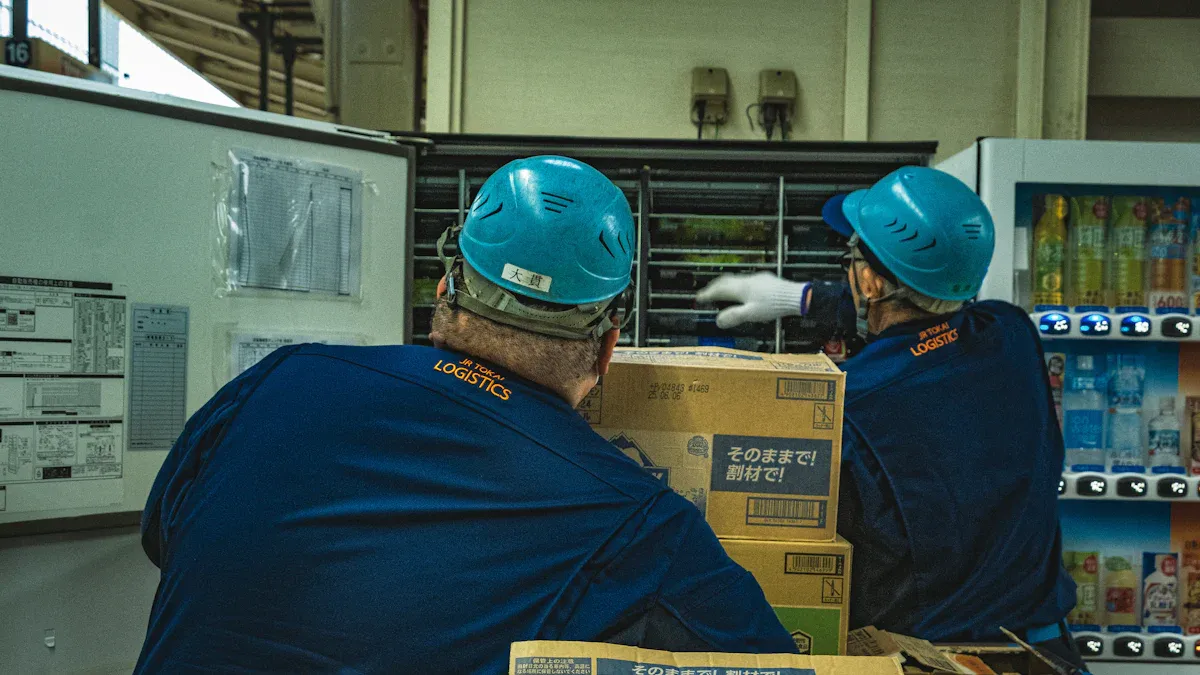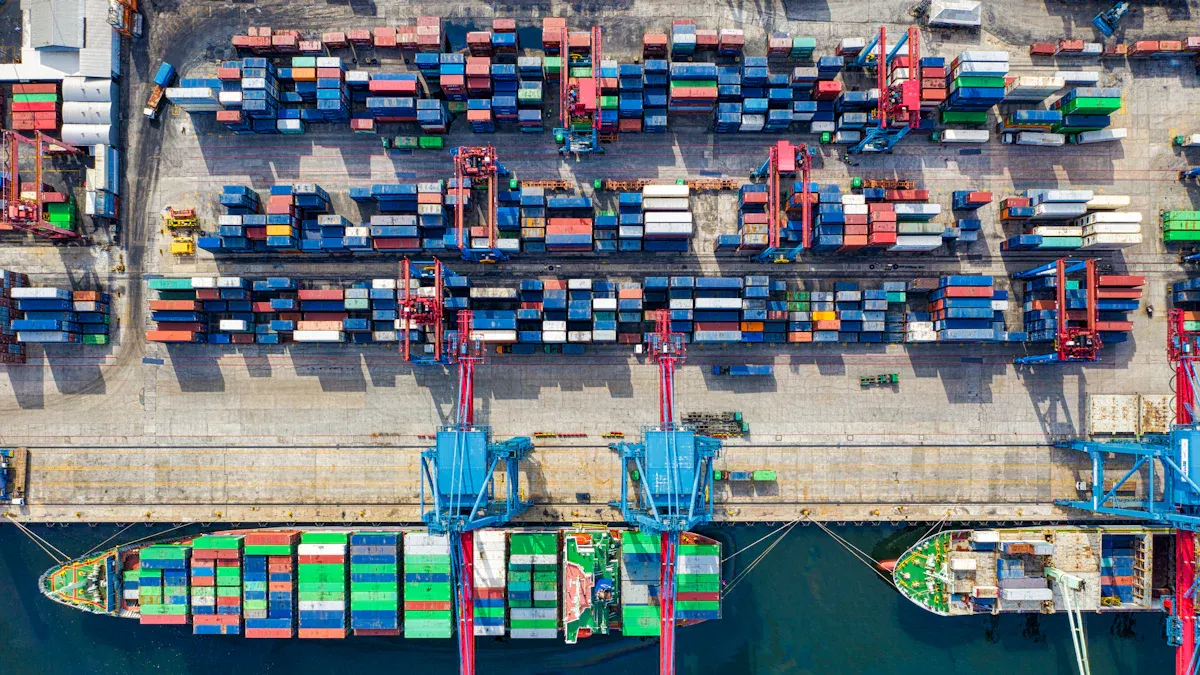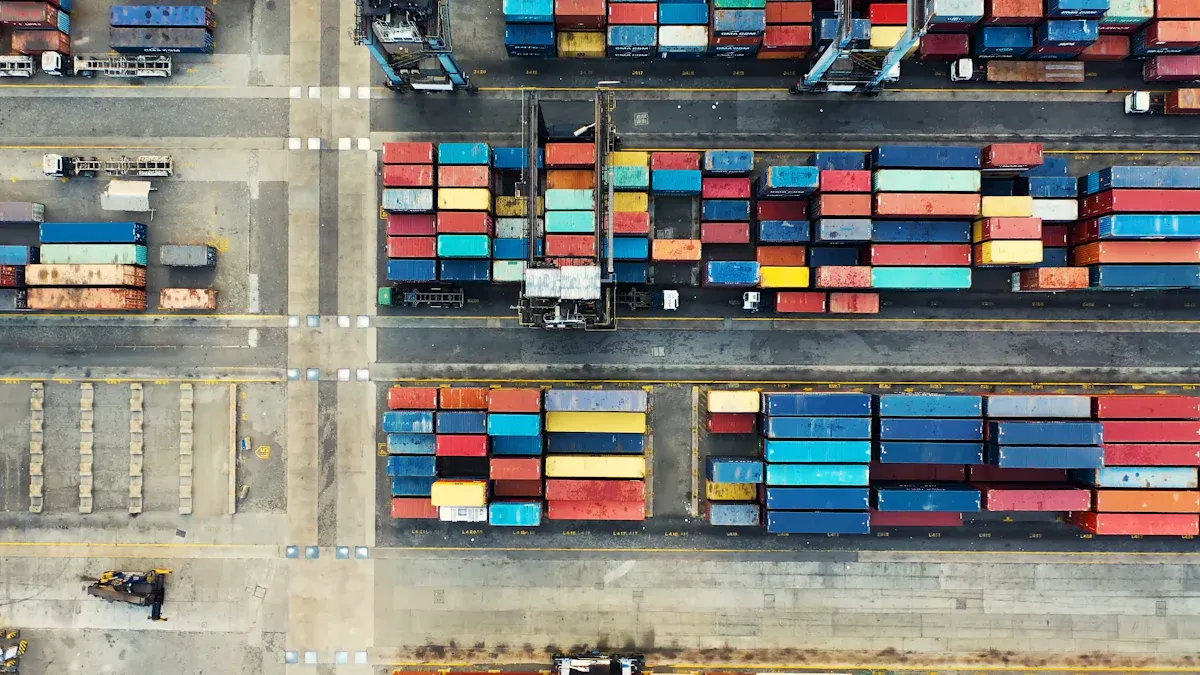Five-Minute Quick Guide to Inbound and Outbound Logistics

Logistics keeps your business running smoothly by getting what you need in and sending finished products out to customers. Inbound Logistics brings raw materials or parts to your factory, while outbound logistics delivers goods to your buyers. You can spot the difference fast: inbound focuses on supply, outbound on delivery. Efficient logistics means fewer delays, lower costs, and happier customers.
Here are some ways logistics performance impacts your business:
Metric | Description | Business Impact |
|---|---|---|
Orders shipped without errors | Higher customer satisfaction | |
On-time Shipment Rate | Orders shipped on or before expected delivery | Better trust and fewer delays |
Shipping Cost per Order | Average cost to pick, pack, and ship | Lower operational expenses |
Key Takeaways
Inbound logistics brings materials into your business on time to keep production running smoothly and avoid delays.
Outbound logistics sends finished products to customers quickly and accurately to boost satisfaction and build trust.
Strong supplier relationships, smart transportation choices, and good timing help reduce costs and improve your supply chain.
Inbound Logistics Overview

What Is Inbound Logistics?
Inbound logistics is all about getting the right materials, parts, or products into your business at the right time. You focus on bringing in everything you need to make your products or keep your operations running. This part of logistics covers the journey from your suppliers to your warehouse or factory. The main goal is to make sure you never run out of what you need, but you also don’t want to fill your space with too much inventory.
Think about a car manufacturer. You don’t build every part of a car yourself. Instead, you work with hundreds of suppliers who send you engines, tires, electronics, and thousands of other components. Inbound logistics helps you organize all these deliveries so your assembly line never stops. If even one part arrives late, your whole production can get delayed.
🚗 Tip: Inbound logistics is the backbone of your supply chain. When you manage it well, you avoid costly delays and keep your business moving forward.
Key Activities
You handle several key activities in inbound logistics. Each step helps you keep your operations smooth and efficient:
Sourcing and Procurement
You start by finding reliable suppliers. You negotiate contracts, set prices, and make sure your suppliers can deliver the right quality and quantity. Good supplier relationships are crucial for strong supply chain management.Receiving and Inspection
When shipments arrive, you check them for accuracy and quality. You want to catch any mistakes or damaged goods before they enter your production process.Storage and Inventory Management
You store materials in your warehouse or production area. You track inventory levels closely. Too much inventory ties up your money and space. Too little can lead to missed sales or production stoppages. Many companies use technology like IoT sensors and automation to monitor stock and reduce errors.Transportation Coordination
You choose the best way to move goods from suppliers to your location. You might use trucks, ships, trains, or planes. Your decision depends on cost, speed, and the type of product. For example, car makers often use trucks for fast delivery of high-value parts, while bulk materials like steel might travel by ship or rail.Timing and Scheduling
You plan deliveries so materials arrive just when you need them. This is called Just-in-Time delivery. It keeps your inventory low and your production steady. If you get parts too early, you waste space. If they come late, you risk shutting down your line.
Here’s how these activities look in the real world:
Volkswagen and General Motors rely on inbound logistics to bring thousands of parts from hundreds of suppliers. Every part must arrive on time for smooth assembly.
Hy-Vee Food Stores improved their inbound logistics by using integrated warehouse and transportation management systems. This helped them boost delivery performance and productivity.
You also face challenges in inbound logistics. Rising fuel costs, labor shortages, and changing raw material prices can make things tricky. You need to balance your inventory to avoid overstocking or running out. Technology helps a lot—automation, real-time tracking, and AI make your supply chain more efficient and visible. Many companies now invest in green logistics, like electric vehicles, to cut emissions and save money.
Here are some trends and challenges you might see in inbound logistics:
Fluctuating fuel and raw material prices
The need for better inventory management
More use of automation and real-time tracking
Growing focus on sustainability
The impact of trade agreements on sourcing and transportation
E-commerce growth pushing for faster, more efficient inbound logistics
Inbound logistics is a key part of your overall supply chain. When you manage it well, you set your business up for success.
Inbound Logistics Management
Supplier Management
You can’t run smooth inbound logistics without strong supplier management. Reliable suppliers keep your production line moving and help you avoid costly delays. When you build good relationships with your suppliers, you get better prices, higher quality, and more flexibility. You also gain a partner who can help you solve problems fast.
Supplier relationship management (SRM) is a big part of inbound logistics. You need to talk with your suppliers often, set clear goals, and measure their performance. Many companies use supplier scorecards to track things like delivery times, order accuracy, and communication. Procter & Gamble, for example, saved 15% on costs and improved quality by 20% just by working closely with their suppliers.
Here’s a quick look at the key metrics you should watch:
Supplier Performance Metric | Description |
|---|---|
On-Time Delivery Rate | Percentage of orders delivered on schedule |
Order Fill Rate | Proportion of orders fulfilled completely |
Lead Time | Time between order placement and delivery |
Flexibility | Supplier’s ability to accommodate order changes |
Communication Effectiveness | Quality and timeliness of supplier communication |
📝 Tip: Meet with your suppliers regularly. Share forecasts and plans. Review their performance and work together to fix any issues. This teamwork keeps your inbound logistics strong and your supply chain running smoothly.
You can also boost inbound logistics by integrating your systems with your suppliers. Some companies even invite supplier staff to work on-site or connect IT systems for real-time updates. This close coordination helps you spot problems early and keep everything on track.
Transportation Choices
Getting materials from your suppliers to your warehouse or factory is a big part of inbound logistics. You have several transportation options, and each one has its own pros and cons.
Trucking works well for short distances and fast delivery. It’s flexible and can handle many types of goods.
Shipping by sea is best for large, heavy, or bulky items that travel long distances. It’s slower but much cheaper than air.
Air freight is the fastest way to move goods, but it costs the most. You might use it for high-value or time-sensitive products.
Rail is great for moving heavy or bulk items over land. It’s more affordable than trucking for long hauls.
When you choose a transportation mode, think about cost, speed, and the type of product. For example, if you need to move car parts quickly, you might use trucks or planes. If you’re shipping iron ore or cement, you’ll probably pick rail or sea to save money.
🚚 Note: The right transportation choice can lower your costs and help you meet tight deadlines. Always match your method to your product and your customer’s needs.
You also need to decide who handles transportation. Sometimes you arrange it yourself. Other times, your supplier takes care of it. Either way, you must stay in close contact to make sure everything arrives on time.
Timing and Coordination
Timing is everything in inbound logistics. If your materials show up too early, you waste space and money. If they arrive late, your production stops. That’s why many companies use Just-in-Time (JIT) delivery. With JIT, you get what you need, right when you need it—no sooner, no later.
You need to plan your orders and deliveries carefully. Share your production schedule with your suppliers. Use real-time tracking tools to watch shipments as they move. Good communication helps you spot delays early and adjust your plans.
Here are some ways to keep your inbound logistics on schedule:
Hold regular meetings with suppliers and transportation partners.
Use technology to track shipments and inventory.
Set up backup plans, like extra stock or alternate suppliers, in case something goes wrong.
Check incoming goods for quality as soon as they arrive.
⏰ Tip: Strong coordination with suppliers and transport partners keeps your supply chain running smoothly. Quick updates and clear plans help you avoid surprises.
Inbound logistics management is all about teamwork, planning, and smart choices. When you focus on supplier management, pick the right transportation, and nail your timing, you set your business up for success. You keep your supply chain strong and your customers happy.
Outbound Logistics
What Is Outbound Logistics?
Outbound logistics covers everything you do to get finished products from your warehouse to your customers. You focus on moving goods out of your business, making sure buyers receive the right items, on time, and in good condition. This part of logistics connects your company to the outside world, whether you ship to other businesses or directly to shoppers at home. When you manage outbound logistics well, you boost customer satisfaction and build trust.
Main Steps
You handle several important steps in outbound logistics. Each one helps you deliver a smooth experience for your customers:
Order Processing
You start by receiving and checking customer orders. You confirm details, check inventory, and prepare the right products for shipping.Warehousing
You store finished goods in your warehouse until they are ready to ship. Good organization helps you find products quickly and avoid mistakes.Packaging
You pack products safely to protect them during transport. Smart packaging also makes your brand look professional and can reduce shipping costs.Shipping and Delivery
You choose the best transportation method—trucks, planes, or even drones—to get products to your customers. You track shipments in real time using GPS or RFID, so you always know where your goods are.Last-Mile Delivery
This is the final step. You make sure products reach the customer’s door, whether it’s a business or a home. Fast, reliable last-mile delivery sets you apart from competitors.
For B2B customers, you often ship large orders to factories or stores. Timing and accuracy matter most. For B2C customers, you focus on speed, convenience, and a great delivery experience. Companies like Amazon and FedEx use advanced logistics technology to make this process fast and reliable. Brands like Zara and Starbucks use responsive supply chains and mobile ordering to keep customers happy.
🚚 Tip: Outbound logistics is your chance to shine. When you deliver quickly and accurately, you win loyal customers and grow your business.
Inbound vs Outbound Logistics

Key Differences
You might wonder how inbound and outbound logistics really differ. Both play a big part in your supply chain, but they focus on opposite directions. Inbound logistics brings materials and parts into your business. Outbound logistics sends finished products out to your customers. You manage suppliers and deliveries in both, but your goals change. With inbound, you want steady supplies and smooth production. With outbound, you aim for fast, accurate deliveries and happy customers.
Here are some quick ways to spot the differences:
Inbound logistics deals with suppliers and raw materials.
Outbound logistics handles customers and finished goods.
Inbound focuses on receiving, storing, and managing inventory.
Outbound focuses on order processing, packing, and shipping.
Timing matters in both, but for different reasons. Inbound timing keeps your production running. Outbound timing keeps your customers satisfied.
💡 Tip: When you balance both sides of logistics, your whole supply chain works better.
Comparison Table
Here’s a simple table to help you compare inbound and outbound logistics at a glance:
Aspect | Inbound Logistics | Outbound Logistics |
|---|---|---|
Main Focus | Getting materials in | Sending products out |
Key Partners | Suppliers, vendors | Customers, retailers, end-users |
Main Activities | Receiving, storing, inventory | Order processing, shipping, delivery |
Goal | Smooth production flow | Fast, accurate customer delivery |
Supply Chain Impact | Keeps production on track | Builds customer satisfaction |
You need both inbound and outbound logistics to keep your supply chain strong and your business growing.
Challenges and Best Practices
Inbound Logistics Challenges
You face several hurdles in inbound logistics. Budget constraints often limit your options for transportation and storage. Coordination with suppliers and transport partners can get tricky, especially when you need everything to arrive just in time. Skilled workers are hard to find, which can slow down your operations. Inefficient vehicle routing increases transportation costs and hurts your efforts at cost reduction. When you struggle with inventory management or procurement, your whole supply chain can feel the impact. These challenges can lead to delays, higher expenses, and unhappy customers.
Outbound Logistics Challenges
Outbound logistics brings its own set of issues. Fast shipping demands can drive up transportation costs by as much as 68%. When you rush deliveries, you also increase CO2 emissions, which is bad for both your budget and the environment. Managing complex fleets and coordinating routes for both inbound and outbound logistics can make cost reduction even harder. If you don’t consolidate cargo well, you waste space and money. Keeping up with customer expectations for speed and accuracy adds more pressure.
Optimization Tips
You can tackle these challenges with smart optimization strategies. Start by using real-time data and analytics to monitor your logistics. Predictive maintenance on your vehicles helps you avoid breakdowns and supports cost reduction. Centralize your data and standardize formats to make analysis easier. Train your team to use advanced analytics and run pilot projects to test new ideas. Real-time dashboards let you spot problems early and adjust quickly. When you focus on optimization, you boost efficiency, cut costs, and make your logistics more sustainable. Every step you take toward better optimization leads to stronger cost reduction and a more reliable operation.
When you master both inbound and outbound logistics, you boost efficiency and keep customers happy. Studies show that strong supplier partnerships, smart transportation, and process improvements lead to higher satisfaction and loyalty. Try these best practices now. You will see better results and happier customers in your business.
FAQ
What’s the main difference between inbound and outbound logistics?
Inbound logistics brings materials to you. Outbound logistics sends finished products to your customers. You manage both to keep your business running smoothly.
How can you improve your logistics efficiency?
You can use real-time tracking, build strong supplier relationships, and choose the best transportation methods. These steps help you save time and money.
Why does timing matter so much in logistics?
If materials or products arrive late, you risk delays and unhappy customers. Good timing keeps your production and deliveries on schedule.
See Also
Mastering Efficient Logistics Strategies In Advanced Manufacturing
Comprehensive Strategies To Reduce Logistics Costs Effectively
Unlocking Supply Chain Savings With Expert Logistics Tips
